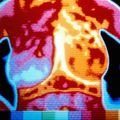 More than 42,000 cases of breast cancer are diagnosed each year in the UK, making it the most common cancer in women after non-melanoma skin cancer. Animal studies contributed to the development of tamoxifen, one of the most successful treatments, and more recently Herceptin and aromatase inhibitors, the effects of which are explained below.
More than 42,000 cases of breast cancer are diagnosed each year in the UK, making it the most common cancer in women after non-melanoma skin cancer. Animal studies contributed to the development of tamoxifen, one of the most successful treatments, and more recently Herceptin and aromatase inhibitors, the effects of which are explained below.
There is a wide range of breast cancer treatments, including the use of hormones to stop the growth of cancerous cells, high dose x-rays and chemotherapy to kill cancer cells, and surgery. The latest option is immune therapy which boosts the body's own disease-fighting system. All these treatments were developed using animals.
Tamoxifen
In the 1950s, scientists found that hormone changes could lead to breast cancer in rats. When tamoxifen was developed in the 1960s, most research was focused on chemotherapy. However, detailed studies in animals indicated that it blocks the actions of the hormone oestrogen and lowers the chance of the breast cancer returning.
Aromatase inhibitors
Although the number of patients surviving for more than five years has risen to 80% over the past 20 years, breast cancer can still kill. New treatments include Herceptin (trastuzumab) and aromatase inhibitors. Aromatase inhibitors block production of the female hormone oestrogen, ‘starving' breast cancer cells of growth stimuli. Professor Angela Brodie of the University of Maryland School of Medicine developed the aromatase inhibitors and tested them in mice, comparing them with tamoxifen, the gold-standard treatment for women with common ‘oestrogen-receptor-positive' cancers.
This research showed how animal models can predict patient response not just to a particular medicine, but to different combinations of therapy - a critical factor in cancer treatment. For example, animal studies with combinations of tamoxifen and aromatase inhibitors did not show any improvement over established treatments.
 Professor Brodie described how aromatase inhibitor therapy alone had been shown to be the most effective. Her preliminary research excited doctors who ran the first clinical trial. It was a success and aromatase inhibitors were approved for use in patients with oestrogen-stimulated breast cancer. Later studies with patients showed that sequential treatment with tamoxifen and then the aromatase inhibitor exemestane improved survival rates for this type of breast cancer, and could save a further 1,300 lives a year in the UK alone.
Professor Brodie described how aromatase inhibitor therapy alone had been shown to be the most effective. Her preliminary research excited doctors who ran the first clinical trial. It was a success and aromatase inhibitors were approved for use in patients with oestrogen-stimulated breast cancer. Later studies with patients showed that sequential treatment with tamoxifen and then the aromatase inhibitor exemestane improved survival rates for this type of breast cancer, and could save a further 1,300 lives a year in the UK alone.
Herceptin
The development of Herceptin is also a landmark. In 2005, researchers reported a study showing a 50% fall in the rate of breast cancer recurrence after one year of treatment. This degree of benefit in early breast cancer was the largest reported since the introduction of tamoxifen. Herceptin only seems to work when breast cancer cells produce too much (over-express) a protein known as HER-2 which normally helps to regulate cell growth. Over-expression of HER-2 occurs in 20% to 30% of tumours in patients with breast cancer.
HER-2 was discovered in 1979 in neurological tumours of rats. It took nearly 20 years to develop Herceptin, a monoclonal antibody that targets HER-2. Animal studies also highlight possible risks in specific groups of patients. For example, Herceptin is not routinely recommended for nursing mothers after studies showed that monkeys secrete it in milk.
For further inmformation see: FASEB'sBreakthroughs in Bioscience essay Breast Cancer, Tamoxifen and Beyond: Estrogen and Estrogen Receptors and the AnimalResearch.info page on breast cancer.




